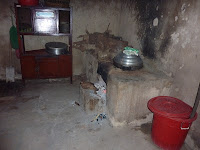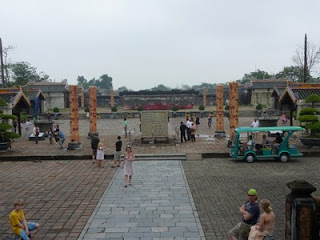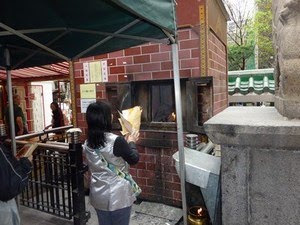If Bangkok is bustling, Hanoi is frenetic - and I loved it.
The city was founded in 1010 and will be celebrating its millenium on 10/10/10. It has a population of six million. It was first captured by the French in 1886.
Our first morning was taken up with a visit to Ho Chi Minh's mausoleum. Queuing for an hour to spend 45 seconds filing past a forty year old corpse is not really my idea of fun, but it was very interesting, nevertheless. There were literally thousands of people viewing the body and Uncle Ho is clearly much loved by the Vietnamese. We were in the so-called VIP queue, so I can't imagine how long it would have taken had we been mere Vietnamese. But it was all done with the utmost good humour and quiet respect. There's not much to say about the body itself. We weren't allowed to get close enough to see any detail, but from where we were it looked more like he was carved out of stone.
Ho Chi Minh died of lung cancer in 1969, aged 79. According to our guide, he never married, but supposedly fathered many children. Wikipedia says he married a Chinese girl, but since Vietnam has subsequently fallen out with the Chinese, maybe this bit has been purged from the records.
He was clearly an intelligent man and spoke five languages fluently, Vietnamese, Chinese, Russian, French and English. He was educated in a French school in Vietnam. The French had colonised the country in 1886, along with Laos and Cambodia, combining the three countries under a single administration.
Before WW1, he travelled to the USA and England, where he worked as a chef. After the war, he went to France for four years, where he began to embrace communism. After that, he went to Russia and worked as a waiter, then to China. He later moved around a lot, spending time in Thailand and Hong Kong and then again in China, Russia and Europe, finally returning to Vietnam in 1941, to lead the independence movement. He had been arrested a number of times on the way, serving various prison sentences. As leader of the communist party, he became Prime Minister in 1945 and President in 1946.
After declaring independence in 1945, it wasn't until 1954 that the French were eventually defeated, at the Battle of Đien Bien Phu. The French, as was their wont, had run a particularly vicious regime, one of their legacies being a prison in Hanoi for political prisoners ("Maison Centrale"), later to become known as the "Hanoi Hilton" (see below).
The Americans, coming out of the Korean War, at the height of McCarthyism and ever-obsessed with communism, were afraid that if South Vietnam fell to the northern communists, then the rest of South East Asia would fall , This was Eisenhower's so-called 'domino' effect. Accordingly, they began to support the South Vietnamese in their defence against the invading north, first by providing advisers, then by sending in combat troops. Step by step, first under Kennedy, then under Johnson and lastly
under Nixon, they fell into an ever-escalating conflict. They were finally defeated by the Viet Cong in 1975, with the fall of Saigon and the evacuation of the last American troops.
Since Ho died in 1969, he never lived to see victory over the imperialists, nor the re-unification of his country.
My impression is that Ho Chi Minh is still much-loved in the north. I did ask our guide if the people in Ho Chin Minh City (formerly Saigon) felt the same, having suffered defeat at the hands of Ho's army and also having been subjected to more western (i.e. Amnerican) influence. He reckoned that the majoriy were very pro-Ho, primarily because they were glad to be re-unified. He did say that there were some who didn't have such a high regard, presumably the dissidents who look for democracy. Of course, such people often end up in gaol. On a later occasion the guide said that he thought the vast majority of the population were also happy with the present government. Some ten or more years ago, the government introduced a lot of reforms under their own version of Perestroika and since that time the lot of the common man has improved enormously. Given the ever-improving living standards (i.e. they are no longer starving!), it is perhaps not surprising that the government is still popular with the people. One wonders what will happen in twenty or so years, when there is a much larger middle class?
After the visit to the Mausoleum, we went to the nearby Ho Chi Minh Museum. This was built by the Russians after Ho's death and is in a typically communistic style. It's full of pictures of Ho working in the fields, opening irrigation projects, kissing babies, etc., along with seemingly endless sets of documents he'd signed and quotations from his high-flown speeches. All very boring.
Lunch, though, was delicious - tempura-style vegetables, followed by a very tasty pork and fish stew with rice, washed down by a couple of beers, all for £6.
After lunch, we went to an Ethnological museum which showed fourteen different Vietnamese ethnic groups, including the vastly different houses that they live in. This was fascinating. We've all seen pictures of how cyclists here load up their bikes and I include one here from the museum. It is the bike used by a well-known fisherman and it shows how he loaded his bike with 800 fishing pots, each of which is beautifully made. You can just about see his saddle. The sculptures of couples were also rather graphic and particularly appealed to the Vietnamese girls.
Later that day, we visited the Hanoi Hilton, referred to above. This was the gaol where captured American airman were held during the Vietnam war. As you would imagine, the conditions were pretty appalling, particulary when it was used by the French, which is what the majority of the exhibit covers. Only a small part of the gaol is still standing, but it does give a fair idea of what it must have been like.
One of the exhibits was the flying suit of probably the most famous inmate, John McCain. He was there until the end of the war in 1973. He returned for a visit a few years ago. One of McCain's fellow inmates, Douglas Petersen, later became the first American ambassador to the Socialist Republic of Vietnam.
The Hanoi streets are truly incredible, so hectic. Hanoi has a population of 6m and it seems that almost everyone has a motor scooter. There are thousands of them on the street, mixed in with the other traffic, but seemingly following few, if any, traffic ruiles. Crossing the road is an adventure. You just have to step out into the road and walk, trusting the traffic to stop. So far, it's worked, and we've not yet lost anyone. Apparently it's likely to be fatal to step back, as there will almost certainly be a scooter swerving to avoid you.
There are pavements, but these are completely unusable for walking since they are fully occupied by a combination of market traders and parked scooters. This means you have to walk in the road, notwithstanding that the traffic may come from either direction, as even one-way signs are ignored.
By law, a motor cycle may only carry two adults and the traffic police will stop any bike with more than this. However, it is OK to add children and, apparently, some couples take as many as five children with them, squeezed in between the mother and father. I only saw parents on a scooter with two children, but one of our party saw three. Our guide said that they had to allow children to be carried as that is the only way they can be taken to school.
Dinner was again very tasty, but it was absolutely imperative to ignore all health and safety considerations. There was no choice of food, just a single dish of what they called grilled fish, but which was actually fried catfish. The scary bit was that the waitresses brought in little burners full of hot coals, topped with frying pans of part-cooked fish. Sparks were flying everwhere and in the cramped conditions, on rickety tables, it's amazing that none of them ever seems to get tipped over. The fire risk must be pretty high and then the chance of getting out down the steep stairs unscathd must be virtually zero. But we made it out safely and the food was great.
After dinner, we went to a Vietnamese water puppet theatre, not something that I would immediately jump at. The stage consists of a pool of rather greenish looking water. The puppeteers stand in the water, behind some sheeting, with the puppets attached to long poles and wiresm, hidden under the water. The whole thing is very colourful and, in our case, was accompanied by a very good eight piece orchestra, using entrely Vietnamese instruments. I did enjoy the show, especially the music, although again the seats were made for midget Asians and so it did become rather uncomfortable.
I wrote this blog as I sat on a coach, bound for our homestay visit, to be the subject of a later blog. It's a good job I wasn't watching the road. I heard all the honking in the background and just looked up to see a four-wheel drive careering towards us on the wrong side of the road, trucks with their headlights flashing, cars overtaking recklessly, motorbikes swerving all over the road, cyclists and pedestrians meandering everywhere and cars pulling out right in front of us. And this was on one of the main highways! It's truly hair-raising, but no one seems to bother. Our guide said
that, on average, thirty-two people are killed on the roads each day, but I think it must be a lot more than that.
The following day began with a ride on a cyclo, a bit like a rickshaw, only powered by a cyclist. I wasn't especially looking forward to this, as it seemed a bit too touristy and not the sort of thing I would normally choose. But it turned out to be a great experience. We went into the heart of the old town and were right in the midst of all the traffic, with scooters overtaking us on both sides, cutting in front of us and generally creating havoc. My driver was, perhaps, a bit more cavalier than most. Whilst I was his passenger, he managed to cause two scooters to crash right next to us, narrowly avoiding me (see picture) and ran over the foot of the girl on another scotter, whilst she was waiting at one of the few sets of traffic lights (where there are lights, they're often ignored). He also took delight in sweriving from side to side, singing 'whoooa, whoooa, whoooa' and laughing as he went. All in all, a very interesting start to the day.
A few (to me) interesting facts:
- If you work for the government and don't have two children, you will lose your job. If you have a third, you will have to pay a fine.
- Education is free, until university.
- There is a lot of corruption in the state-run schools - money buys you the grades you need and access to the best schools, but children of goverment officials get no privileges (not sure I believe that).
- They do eat a certain kind of dog, but it is expnsive. They also eat moles, rats, silk worms, locusts and grasshoppers.
- Ho Chi Minh wanted to be cremated, but the other officials decided his body had to be retained.
- Vietnam claims to be the second largest coffee exporter in the world.
- Our guide is an Arsenal fan.






















































